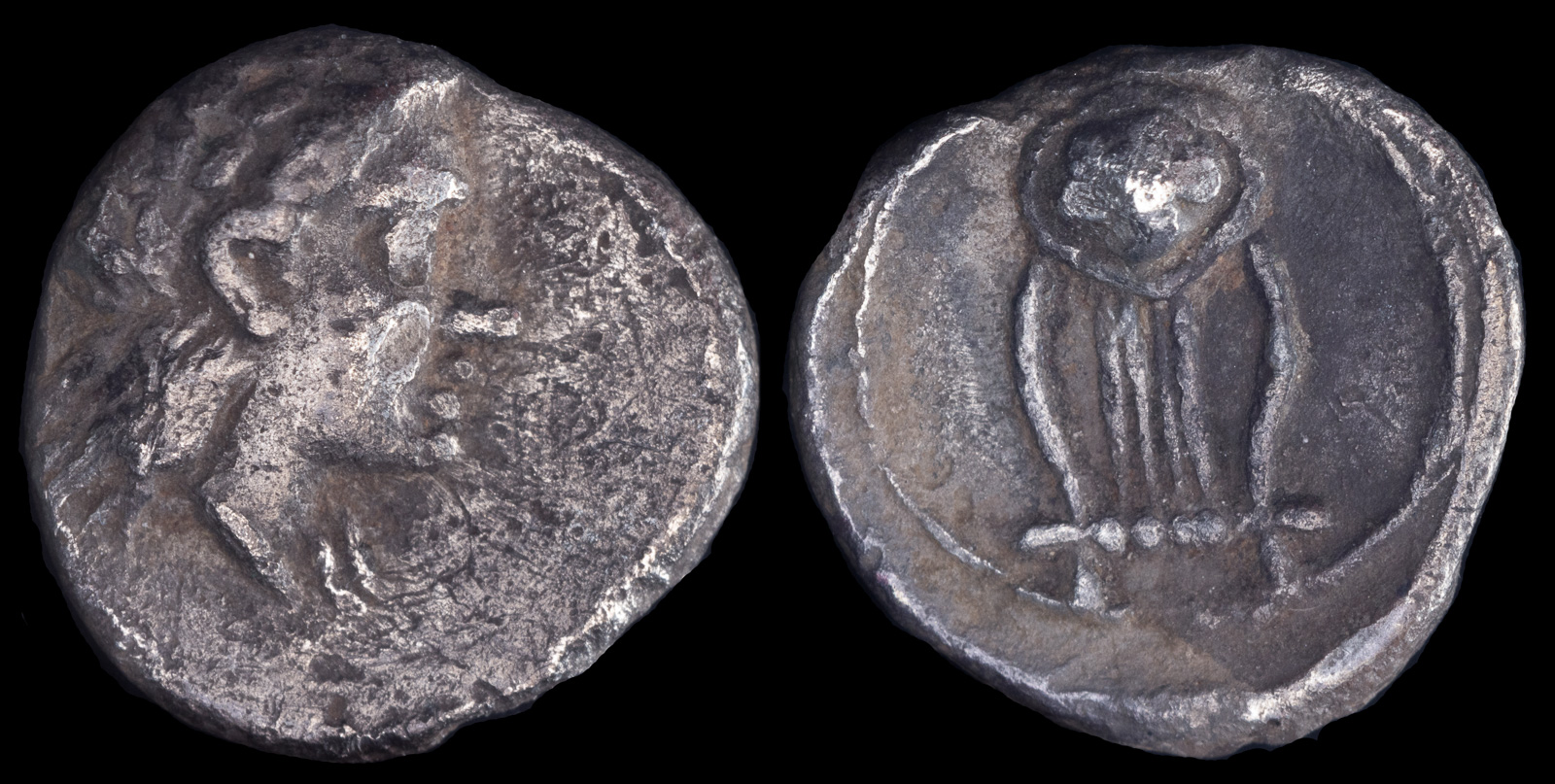
Cyclades, Kythnos
4th century BCE
AR Hemiobol(?) 8.5mm, 0.47 g, 2h
Laureate head of Apollo right /
Chelys within linear circle
Unpublished in the standard references, but cf. HGC 6, 607 for a similar bronze issue from Kythnos
According to Aristotle, Kythnos was awesome. This awesomeness was a result of its constitution, about which we know nothing except Aristotle supposedly considered it awesome. Did it provide free beer on Fridays? Could you legally smash your neighbor’s kithara if he played it too loud? We’ll never know.
According to Herodotus, Kythnos was first settled by a people called the Dryopesin the 13th century BCE, and was named after their King Kythnos. They were eventually pushed out by Ionians, who in turn were crowded away by Dorians. Archeological evidence indicates both the Ionian and Dorian accents were used.
Kythnos was the site of an odd spectacle in 68 CE, when Nero, who everyone had considered deceased, since he’d cut his throat with a dagger, collapsed, and had been buried, miraculously showed up on the island’s shores and presented his Id card. However, Nero had tired of the travails of being emperor, and was satisfied to engage in healthy piracy. Unfortunately, one of the ships he met was that of Calpurnius Asprenas, who was on his way east for a new governorship, and promptly put the new Nero in the same place as the old one. There are rumors that a film is in production about the incident, called “Pirates of the Aegean”, and not starring Johnny Depp.
The city gave two ships for the Battle of Salamis, then celebrated the feat with a souvenir plaque at Delphi. They also housed a group of Parians who decided to hang out in their thermal springs while waiting on the outcome of the battle.
Piracy was actually a big business on Kythnos during ancient times, and numerous writers such as Demosthenes and Plutarch admonish them for it. Eventually the piracy gig got old, so they naturally switched to making cheese.
Pliny in particular noted the island for its excellent cheese. That practice continues today, and two famous (at least among Greeks) cheeses come from Kythnos today. There’s Trima, or zimoto, which has a sour, buttery taste and a little saltiness. Then there’s kopanisti, which has a more peppery taste. They also have their own version of feta. It’s incredibly likely that someone had my coin on him while he ate some cheese.
Kythnos is also famous for its pies, called sfoungato, which are made from the cheese. There’s also the pitaro, which is a pie made of cheese stuffed with fresh cheeses. If you haven’t caught on by now, everything in Kythnos is cheesy.
Other products of Kythnos are its wines – they produce both reds and whites – and thyme honey.
From ancient times until now, the island was also famous for its thermal springs of Loutra, the only thermal springs in the Cyclades. There are multiple springs and may be used today. They’re supposedly great for skin diseases, so keep that in mind before you step in.
The ruins of the ancient city of Vryokastro, which was the primary city, are still visible and excavations have taken place. It was continuously inhabited from the 12th century BCE to the 7th century CE, when it was abandoned for the safer location of Kastro tis Orias. The excavations have so far uncovered over 2000 clay figurines, mostly female, and a number of coins. The figurines were found in buildings believed to be temples to Demeter and Kore, based on inscriptions found. Another temple is believed to have served Apollo and Artemis. That likely explains what is believed to be the image of Apollo on my coin.
My particular coin is notable for the fact that it’s silver, while all previously known coins from the island have been bronze. The attribution is pretty certain, though, based on the facts that the obverse and reverse are similar to the known bronze coins, the KY city ethnic is present, and a similar example was found in excavations on Vyrokastro. In the articles I found on the excavations, the similar coin was mentioned as one of the most intriguing discoveries.
September 26
Aegina plays a significant role in the Greek naval victory against the Persian Empire in the Battle of Salamis. Byblos, Arados, Tyre, Halikarnassos under Artemisia, Kos, and Sidon support Darius. Chalkis and Kythnos support the Greek effort. Alexander I serves as a peace negotiator on behalf of the Persians.
Soldiers of Philip V construct a defensive fort on Kythnos.